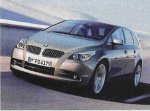This is clipped from Automobile Magazine, there are some pics which I will scan later tonight:
"Ask any BMW official if the carmaker is developing a minivan, and the answer is likely to be an unambiguous no. Reword your question, avoid the moniker, replace it with the term multi-functional high-roof vehicle, and the reply is more positive. "This is a segment we are monitoring with great interest," acknowledges Burkhard Goeschel, board member in charge of R&D. "We are defining a so-called space-functional concept dubbed RFK" (in German, Raum-funk-tionales Konzept).
BMW knows it must not surrender this increasingly important market segment to Mercedes-Benz, which is preparing three crossovers. The RFK strategy is to use existing component sets from the 2004 1-series, the 2005 3-series, and the new 5-series. The corresponding model names will be V1, V3, and V5.
The proposed BMW sport vans are not rebodied X3s and X5s. The proportions are primarily defined by the H-point (H as in hip), which describes the seating position and thus, to an extenct, the height of the roof. For both RFK1 (1- and 3-series) and RFK 2 (5-Series), the H-points are about halfway between those of the wagon and those of the X3 and the X5.
The full-size V5 van could get a cleaver lane-departure warning device that incorporates drive-by-wire steering, a driver-aleart system, active camber and crosswind compensation, and a sensor-governed lane-guidance function. BMW insiders claim the vehicle will combine the rominess of a large wagon, the prestige of a luxury sedan, the go-anywhere traction of an SUV, and the driving dynamics of a sporty coupe. If such a senario actually comes to pass, it would indeed make minivan history, but we'll wait for hte test drive.
The V5 will get BMW's next-generation six- and eight-cylinder engines. While the M engines will remain normally aspirated, high-revving units, BMW's top-of-the-line, none M powerplants will be turbocharged. Expect the NG6T32 (new-generation, six-cylinder, turbo 3.2-liter) to deliver about 300 horsepower and the NG8T45 to smash the 400-horsepower barrier. BMW's new crossovers also should benefit from the automated manual gearbox known as ZSG (Zentral-Synchron-Getriebe, or central synchromesh gearbox). Unlike Audi's DSG system, ZSG makes do with only one clutch driving the permanently engaged central input shaft.
When can we expect the first BMW crossover to hit the market? Since neither RFK project has been approved yet, the earliest possible introduction date is mid-2007. -Georg Kacher"
"Ask any BMW official if the carmaker is developing a minivan, and the answer is likely to be an unambiguous no. Reword your question, avoid the moniker, replace it with the term multi-functional high-roof vehicle, and the reply is more positive. "This is a segment we are monitoring with great interest," acknowledges Burkhard Goeschel, board member in charge of R&D. "We are defining a so-called space-functional concept dubbed RFK" (in German, Raum-funk-tionales Konzept).
BMW knows it must not surrender this increasingly important market segment to Mercedes-Benz, which is preparing three crossovers. The RFK strategy is to use existing component sets from the 2004 1-series, the 2005 3-series, and the new 5-series. The corresponding model names will be V1, V3, and V5.
The proposed BMW sport vans are not rebodied X3s and X5s. The proportions are primarily defined by the H-point (H as in hip), which describes the seating position and thus, to an extenct, the height of the roof. For both RFK1 (1- and 3-series) and RFK 2 (5-Series), the H-points are about halfway between those of the wagon and those of the X3 and the X5.
The full-size V5 van could get a cleaver lane-departure warning device that incorporates drive-by-wire steering, a driver-aleart system, active camber and crosswind compensation, and a sensor-governed lane-guidance function. BMW insiders claim the vehicle will combine the rominess of a large wagon, the prestige of a luxury sedan, the go-anywhere traction of an SUV, and the driving dynamics of a sporty coupe. If such a senario actually comes to pass, it would indeed make minivan history, but we'll wait for hte test drive.
The V5 will get BMW's next-generation six- and eight-cylinder engines. While the M engines will remain normally aspirated, high-revving units, BMW's top-of-the-line, none M powerplants will be turbocharged. Expect the NG6T32 (new-generation, six-cylinder, turbo 3.2-liter) to deliver about 300 horsepower and the NG8T45 to smash the 400-horsepower barrier. BMW's new crossovers also should benefit from the automated manual gearbox known as ZSG (Zentral-Synchron-Getriebe, or central synchromesh gearbox). Unlike Audi's DSG system, ZSG makes do with only one clutch driving the permanently engaged central input shaft.
When can we expect the first BMW crossover to hit the market? Since neither RFK project has been approved yet, the earliest possible introduction date is mid-2007. -Georg Kacher"


